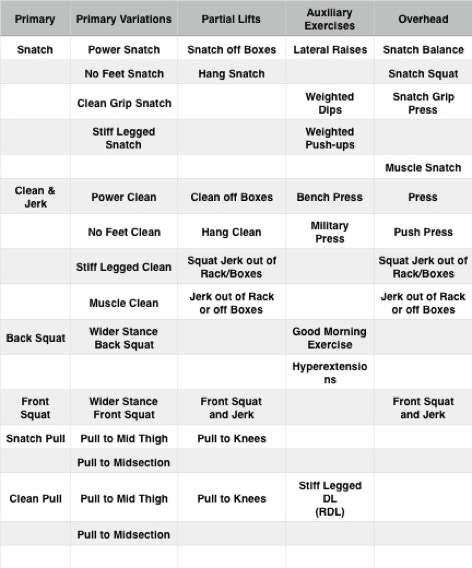Videos
Ratios of Clean & Jerk
to Squat among the top lifters in the world
Ruslan Nurudinov
Artem Okulov
Lasha Talakhadze
Lydia Valentin
Stefan Botev
Christina Lovu
Ilya Ilyin
Rebeka Koha
Fares Elbakh
Loredana Toma
Urik Vardanian
Blagoy Blagoev
Yury Zakharevich

Class of Lifts
Written by Jim Napier
It is important to list the events and exercises in their proper classification so those lifts and exercises can be viewed as to their importance and necessity, as well as to their benefit. There are five classifications of lifts as listed below;
1. Primary
2. Variations
3. Partials
4. Auxiliary
5. Overhead
Some of these lifts and exercises overlap and I have put those in whatever classification seemed to be proper. Below is the classification table;
The first column lists the primary lifts as they exist in their purest form. Everything else would be considered as an exercise or as an assistance to those primaries. Variations that are executed off the platform will be closer to being primaries than the partials, but neither the variations or partials should be considered auxiliary exercises. Auxiliary exercises do not contain reactionary extensions or athletic changes in direction, and are performed in a rhythmic nature.
The primary lifts will have to be reduced in intensity, volume and frequency in order to fit all these exercises and lifts into a short period of time, unless the lifter is a professional. Of course even that would depend on the intensity level used in any particular lift or exercise, however it is precision and velocity that should control the intensity and volume levels of any particular lift or exercise or training session.
Since the variations are considered primaries, with some exceptions, those variations can be worked into the programming with little problems concerning the available time allocated. Doing a power snatch is not much different from doing a full snatch. Variations only alter the style of the lifter with respect to grip spacing, foot spacing, foot action and other style adaptations that do not change the overall technique of the lifter, but aid in keeping the lifter from becoming stale by doing the same thing over and over. It also aids in creating some mobility and even some additional flexibility, such as the snatch with a clean grip.
Partial lifts are mainly characterized by the elimination of the 1st pull or part of the 1st pull. There are very few auxiliary exercises and most of those have more to do with the overall conditioning and fitness of the lifter. Most coaches categorize partial lifts as auxiliary exercises, but they are not exercises if they contain portions of the full movements. Categorizing partial snatches and cleans and jerks as auxiliary exercises is a big mistake and usually causes those partial lifts to be looked upon as something that can fix a technical problem or a weakness. This of course is not possible, since those problems are a direct concern of the full movement and weaknesses are a concern of the training methodology.
Some of those variations and partials can be used as warmup protocols, such as the muscle snatch, power snatch and clean, hang snatch and clean, although the hang snatch and clean are rarely used with anything other than the empty bar, the snatch high pull is also used with the empty bar just to loosen up the shoulder girdle area. The main emphasis in pre-warmups is to get ready for the incremental increases.
Partial lifts have one thing in common, they would all be disqualified in a competition, because the rules state the weight must be lifted off the platform in one continuous motion to lock-out in the snatch and to the shoulders in the clean. No hitching (hangs or boxes) or press out (muscle snatch and push press) is allowed. This alone requires some careful consideration as to the necessity of those so called exercises, at the very least partials should never be pushed to maximal efforts. The two possible exceptions would be the jerk out of the rack and the snatch off boxes. Exceptions in the sense that these two partials seem to be contested in training almost as much as the primaries. An occasional stab at a maximal effort in those partial will not disrupt the training of the primaries. It is only when those two lifts are trained for the purpose of setting PRs will that interfere with the main purpose of training, which is to ready the lifter for competition in the snatch and clean & jerk off the platform, not out of the rack or off boxes.
